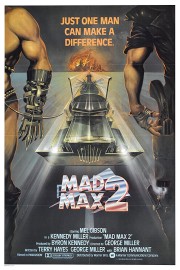The Road Warrior
It’s interesting that now, two generations have grown up with two differing views of Australian filmmaker George Miller. A younger generation will be primarily familiar with his family offerings “Happy Feet” and the “Babe” films (only the sequel of which- “Pig in the City”- he directed). Meanwhile, my generation knows him from his Australian outback actioners with Mel Gibson. The controversial star-director, now more known for his private life than his films, has seen a lot of love in my Movie a Week series, and I’m not done yet, but such is my continued admiration for his movies in spite of his questionable personal choices.
Admittedly, watching the 1982 “Mad Max” sequel “The Road Warrior” again, this should’ve been reviewed the week of “Terminator: Salvation” with its’ post-apocalyptic vision and hard-core action, while the robot-centric “Ghost in the Shell” should’ve been this week with “Transformers: Revenge of the Fallen.” No worries- Miller’s action sequel was worth waiting for, and is a standard of the genre to this day. Let’s put it this way- both McG and Michael Bay could learn a thing or two from Miller’s film.
I still haven’t seen the 1979 cult classic that spawned the “Mad Max” series (and Gibson’s career), but seeing “The Road Warrior” again made me even more anxious to get to it at some point. In a story that could easily be seen as relevant now, in a futuristic world where war has ravaged the land, gas is a precious commodity people will die for. In this land, Max lives on the outskirts of the new society. His family murdered, his loyal dog at his side, he’s a man who lives only for himself. A chance encounter with a gyro captain (Bruce Spence) when his car runs out of gas leads him to a group of people who live at a refinery full of the precious fuel. Originally, Max is looking just to get himself some fuel so he can be on his way, but when a band of murderous thugs- led by Lord Humungus (Kjell Nilsson)- threaten the civilization and their supply, Max is drawn into helping them keep their fuel safe.
The screenplay by Miller, Terry Hayes, and Brian Hannant is less interested in social commentary than it is grunge-and-grind action sequences. But here’s the thing- the action is driven by the story, which is driven by characters, who are driving plenty of vehicles that can be crushed and mangled in several imaginative ways. But the social implications of the story are never far from the tip of our mind, especially at a time when oil consumption has led to worldly unrest in the here and now. But Miller and co. know that we come to a movie called “The Road Warrior” because we want to see road warfare, and Miller delivers the goods in a big way, especially when Max takes the wheel of a tanker as the white-clad “good guys” try to escape the hoards led by Humungus. Shot by Dean Selmer (who would later shoot Gibson’s “Apocalypto”), scored by Brian May (not the Queen guitarist, but just as talented), and edited were verve and intensity by Michael Balson, David Stiven, and Tim Wellburn, the car chase sequences are a gold standard for the cliche in brutality and composition, and for the fact that, well, it all comes naturally out of story rather than just being a product of action nonsense. Often imitated, but rarely duplicated, “The Road Warrior” delivers a level of action cool and story simplicity that still delivers today, as much because of Gibson’s stoic but forceful performance as for the saga unfolding around him.










